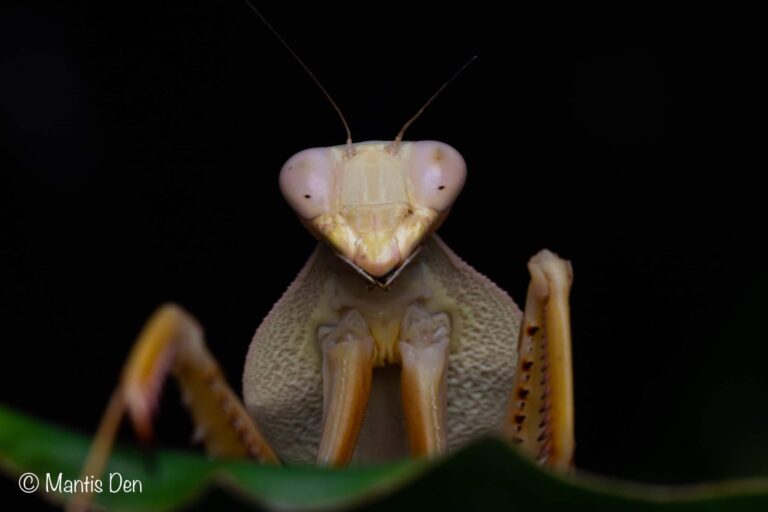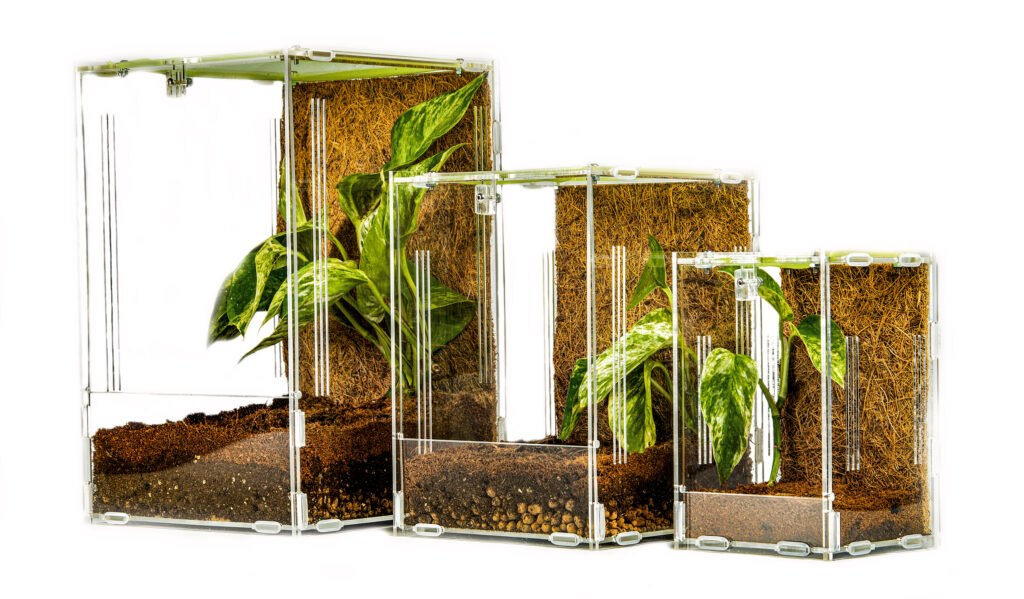PRAYING MANTIS CARE
Temperature & Humidity
Most mantis need to be kept at a higher temperature as they mainly originate from Africa, Asia, South America and other warmer environments. This may mean keeping them in a room with a space heater to ensure its warm all the time or using a heat mat (with mat stat) or heat lamp (with thermostat), particularly in the colder months. Different species will have different temperature requirements. Most species require in the range of 25-30C & 60%+ humidity but please check the specific requirements of any species.
If using heat mats, ensure they’re placed on the side of the enclosure and not underneath so they can move away from the heat.
A water bottle on a mist setting with spring water is recommended (tap water has added chemicals that may harm your mantis).
Mantis will drink this water from the leaves or the sides of their enclosures, but also get water from the foods that they eat.
It is important to have a thermometer and hygrometer in your mantis enclosure to ensure correct temperature and humidity levels are maintained.

Adult size & Gender Determination
Males tend to be smaller than females. This is more pronounced in certain species for example orchid mantis, where the adult male is about half the size of the adult female.
Depending on species, mantis can vary from 1cm when fully grown, right up to 17cm, so best to do your research on the specific species you’re interested in. This is particularly important when choosing which enclosure to go for.
Most become adults at L7 or higher although there are exceptions based on species & sex.
You can determine gender around L3 (species dependent) by counting the abdominal segments. Males have 7 or 8 segments on underside of the abdomen and females have 5 or 6.
Some species have other indicators that help determine gender, so best to research individual species.
Feeding
Mantis eat predominantly flying prey, progressing from Drosophila Hydei fruit flies when smaller, to green bottles and then blue bottle flies.
Some species may require even smaller prey when nymphs so please check with your supplier what they recommend.
They may also enjoy wax worms and wax moths at later instars.
Some mantis will also eat locusts as they get bigger.
Crickets should never be fed to your mantis as they can carry diseases that may harm your mantis and they’ve also been known to bite or even kill mantis.
It is important to supervise feeding of bigger prey items to ensure no harm comes to your mantis. Remove any prey that has not been eaten that day.
There is no set rule for how often mantis should feed, go by the size of their abdomen. A flatter abdomen indicates hunger, a satisfied mantis will have a plump abdomen.
Mantis can sometimes go off their food just before they moult, if they don’t eat and look like they might moult, ensure prey is taken out of the enclosure as moulting can be a delicate time during which any uneaten prey could cause harm to your mantis.
Moulting
Moulting is the process of shedding the exuvia and replacing the exoskeleton and is how mantis grow.
Mantis tend to moult on average every 3-5 weeks but this depends on their environmental temperature & humidity and how much & how often they eat.
A mantis requires 4-10 moults to reach adulthood dependent on species and gender. You know they’ve reached adulthood when they grow their wings.
The time between moults can vary due to the age of your mantis, the temperature and humidity you’re keeping them at, the species of mantis and even how much and how often they’ve been eating.
The whole process can take 20-30 minutes, unless its moulting into adulthood which will take significantly longer due to needing to ‘inflate’ their wings.
It’s important not to disturb this process as it can cause a mismoult which can lead to injury or death.
After a mantis has moulted it is not fully dry for 48 hours (less time in younger mantis and longer the closer to adulthood).
It is important to wait until your mantis is fully dried before trying to feed or handle them, do not be tempted to rush this process as they are still very fragile at this time.
Signs that a mantis is about to moult are usually reduced or no appetite, lethargy, wanting to hang & a plump abdomen without recent feeding. If you suspect a moult is imminent then make sure your mantis is on the mesh roof & has plenty of space to hang & moult to potentially double its size without hitting an obstacle.

Housing
A Mantis Den small enclosure with a mesh roof and built in cross-ventilation is an ideal enclosure for most mantises for the first few moults dependent on size. At which point they may need moving to a bigger enclosure. Mantis Den offers a range of purpose built enclosures suitable for all species & sizes of mantises.
It is important that a mantis is in the correct size enclosure for its size, too big and it may not catch its prey.
A general guide is the enclosure height should be at least 3 times taller than the mantis and twice as wide.
A smaller enclosure may mean the mantis does not have enough room to moult which can cause injury or death.
Acrylic enclosures are best however some species need entirely mesh enclosures (for example a Thistle mantis or Devil’s Flower mantis) as they struggle to grip acrylic.
Whichever option you choose, you must ensure the tops of the enclosure are mesh. This gives ventilation but also allows the mantis a place to hang to moult from.
In the bottom of the enclosure it is important to use a substrate such as coco fibre which will retain water from the misting process & release it as humidity. Ensure you are cleaning it out regularly to prevent mould or bacteria growth.
Decoration branches or twigs should be bought from a shop where it will be ready treated. If you bring it out of your garden, ensure it is washed and then put in the oven for 1 hour at 100°C to ensure you kill any pests or bacteria.
Some flower mantis have difficulty climbing the sides of acrylic enclosures so mesh needs to be added to the sides or kept in a mesh enclosure.
Must have adequate cross ventilation as stagnant air for prolonged periods can kill a mantis.
Keep their enclosures minimalist with a few places to hang from until adult to prevent obstacles to moulting.
Can be kept in a bigger enclosure from earlier but may need to be moved to a smaller container for feeding to ensure not having problems catching their prey.
Mantis are better kept individually due to a high risk of cannibalism
If housing multiple mantis separately but in the same room, ensure they are not next to each other or you create a ‘screen’ between them as if they can see each other they may rub their faces against their enclosures to get a better look, causing an injury called ‘eye rub’.
Most mantis will be fine in a Mantis Den large once adult.
*Make sure you research your specific mantis care, this guide is just a starting point to your journey*
*Never house a mantis in a glass container, this does not allow for adequate ventilation and can ultimately kill a mantis*

